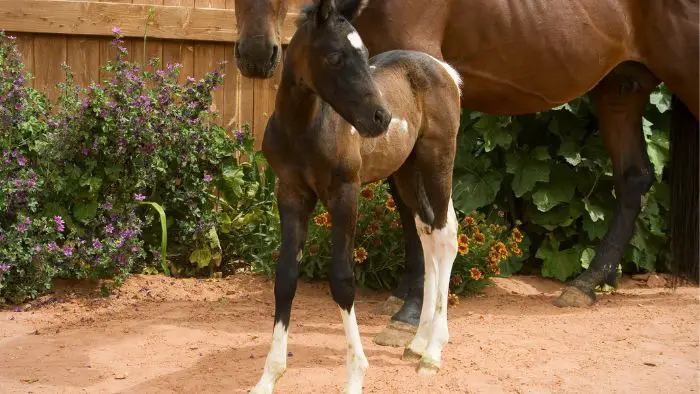Last Updated on July 3, 2022 by Guillermina
There are quite a few terms for baby horses, but not all of them are correct. If you’re stuck on how to refer to your newborn horses, I’ve got you covered!
In this article, I explain where the term for baby horses came from when the right time is to refer to a baby horse by specific names, and some interesting facts about baby horses that you may not know.
The Term For Baby Horses
Equine owners refer to their horses differently depending on their age. To someone with little knowledge of horses, the name you use to describe a baby horse won’t matter. If you’re dealing with a breeder or equine owner, you might want to know the difference!
Before Age One
An equine or baby horse up to one year old is called a foal regardless of its gender.
While they are still drinking or nursing from a mare, they’re also called suckling. Once foals stop nursing at about 3 to 6 months, they’re sometimes called a weanling until they turn one.
After Age One
After a baby horse turns one year old, some people start calling them a yearling colt or a yearling filly until they reach two years of age.
From the age of two up to four years old, foals are named based on their genders. Female foals are called filly, and males are known as colt.
After Maturity
We only start referring to horses by their adult terms when they’re older than five years. A mature male horse is called a stallion, and a female horse is called a mare.
Note: You shouldn’t confuse a foal with a pony. These two are different since a pony will stay small regardless of age. Baby ponies and donkeys are, however, also called foals.
Where Did The Term For A Baby Horse Originate From?
The term for baby horses was used as early as the 12th century. It originated from different translations.
- Middle English – File
- Old High German – Folo
- Old English – Fola
- Latin – Pullus
- Greek – Pais
All these words have been bent and adjusted slightly to become one word. In all cases, the term foal referred to the young or a child of an animal, but never specifically to a horse. The term has become linked to baby horses over the years.
Can You Ride a Foal?
No.
You should never ride a foal. While a horse is still a foal, their bodies aren’t mature enough to be ridden. If you ride your colt or filly, they could sustain serious injuries.
You should refrain from riding your young horses until they’re at least three years old. By this time, their muscles and bones have developed enough to carry extra weight.
Always wear a saddle when riding your young horse. Doing this will help protect them and you.
Note: Ponies are miniature but can be ridden with caution. If your pony is properly trained, it can carry children. Larger ponies will have the strength to carry a moderate-weight adult.
10 Interesting Facts About Baby Horses
- Mares are in foal for about 11 months. Foals can be born a bit earlier or later, but they’re considered full-term and healthy around this month.
- A foal can stand up on its own legs in the first hours after birth. They typically stand up and begin nursing in about 2 hours. After 24 hours, they can start galloping around.
- Mares prefer to foal quickly and mostly at night because, in the wild, this would protect them from any predators when they are very vulnerable. You’ll find a mare foaling between midnight and 6 am.
- Sometimes a foal will start mirroring the mare’s behavior at 10 days old by eating hay or grass. They don’t need these extra nutrients until about two months old but enjoy imitating and learning from their mothers
- Foals and their mothers may look like they are just acquaintances except for the nursing part, but they have a very strong bond. You can’t see it, but they communicate their love for each other with eye contact.
- A foal is born with legs that are 80 to 90 percent fully grown. They are born with long legs because they need to keep up with the rest of their herd and run fast enough when predators come too close.
- Most foals are toothless when they are born.
- Foals are born without an immune system, and a mare’s milk provides them with everything they need to be healthy.
- They communicate with older horses by making a movement with their mouths, almost like how babies talk.
- Some foals are born with bowed legs, called windswept because they were too large for the mare.
Wrapping Up
Naming your baby horse whatever you like between friends won’t make much difference, but if you’re amongst breeders, you’ll have to use the proper term. If you don’t, they might get confused.
Knowing what horses are called at which age will also help you better understand when horse experts talk about them.
I hope this article was insightful and that you have a better idea of what to call your horse at each stage of their life. If you have any more questions about foals, ask them in the comments!
FAQs
What is the difference between a foal and a colt?
The term "foal" refers to a horse of either sex less than one-year-old. Male horses are referred to as colts.
Is a foal a boy or girl?
A foal can be a boy or girl horse. Boys are also called colts, and girls are called fillies.
What kind of animal is a foal?
A foal is a female baby horse.
Is a foal a baby?
Yes.
The term "foal" describes a horse under the age of one.

